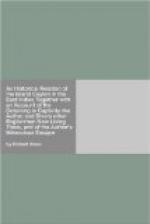[The Carowala.] There is the Carowala, about two foot in length very poysonous, that lurks in the holes and thatch of houses. The Cats will seize these and kill and eat them.
[Gerende.] Other Snakes there are, called Gerende, whereof there are many but not venomous. Of the former there are but a few in comparison. These last mentioned the greatest mischief they do, is to destroy young Birds and Eggs, and young Hares. Rabbets cannot be kept here to run wild, because of these and other Vermin, such as Polecats, Ferrets, Weazels, &c.
[Hickanella.] Hickanella, much like a Lizzard, venomous, but seldom bites unless provoked, these ly in the thatch of the houses.
[A Great Spider.] There is a Spider called Democulo, very long black and hairy, speckled and glistering. Its body is as big as a mans fist with feet proportionable. These are very poysonous; and they keep in hollow Trees and holes. Men bitten with them will not dy, but the pain will for some time put them out of their Sences.
Cattle are often bit by some of these Snakes, and as often found dead of them, tho not eaten. Treading upon them sleeping, or the like, may be the cause of it. When the people are bitten by any of these, they are cured by Charms and Medicines, if taken and applyed in time.
There are also a sort of Water Snakes they call Duberria; but harmless.
Alligators may be reduced hither: there be many of them. Of which we have said somewhat before.
[Kobbera-guion, a creature like an Alligator.] There is a Creature here called Kobbera guion, resembling an Alligator. The biggest may be five or six foot long, speckled black and white. He lives most upon the Land but will take the water and dive under it: hath a long blew forked tongue like a sting, which he puts forth and hisseth and gapeth, but doth not bite nor sting, tho the appearance of him would scare those that knew not what he was. He is not afraid of people, but will ly gaping and hissing at them in the way, and will scarce stir out of it. He will come and eat Carrion with the Dogs and Jackals, and will not be feared away by them, but if they come near to bark or snap at him, with his tayl, which is about an Ell long like a whip, he will so slash them, that they will run away and howl. This Creature is not eatable.




